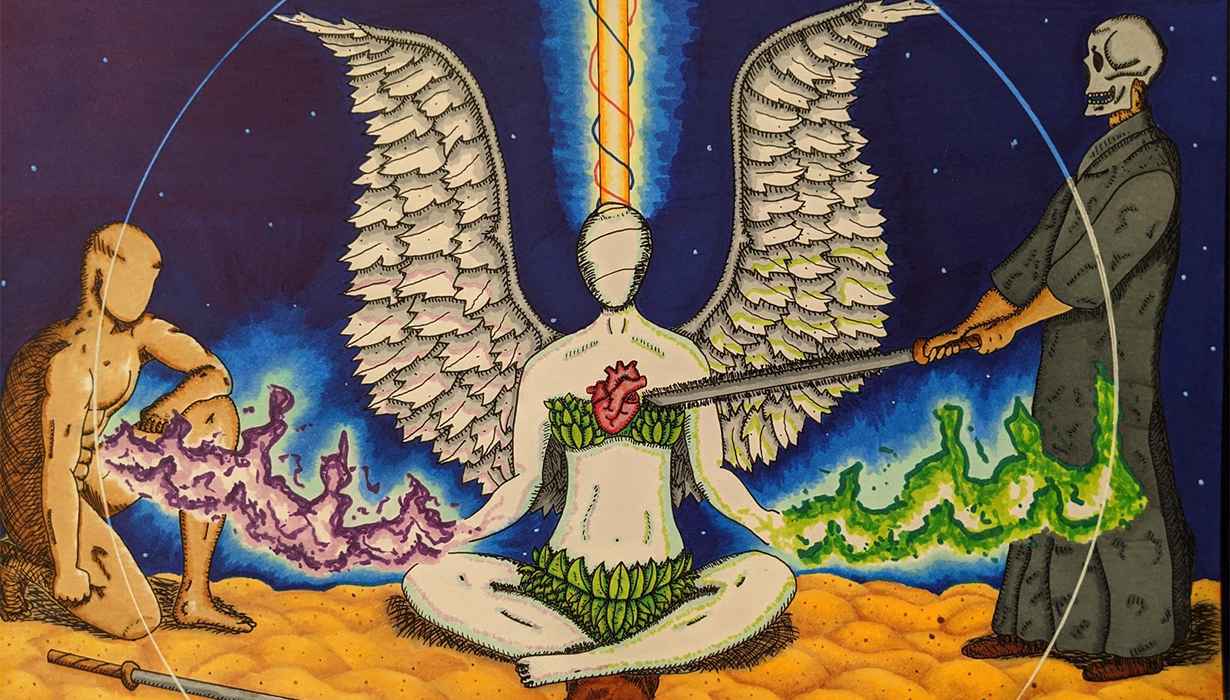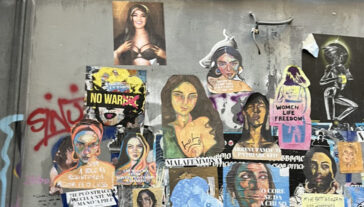Explore Three Powerful Works of Art in SAPAC’s Art Show Revolution: Transformation

The Sexual Assault Prevention and Awareness Center’s (SAPAC) 16th annual art show, “rEVOLUTION: transformation” aims to serve as a space for UM student victims and allies to bring awareness to the effects of sexual assault and the difficult, but necessary process of healing through creative expression. I interviewed three artists featured in the art show on Thursday to understand their art and what this exhibition means to them. Each of their artworks vary in subject matter, but together they form a story of healing and reflection.
First I interviewed Liv Evans, a Creative Writing major at the University of Michigan. Liv told me that their poems, “fifth grade” and “seventh grade” reflect on the formative stages in people’s lives where you feel like something’s not right, but don’t exactly know at the time what it means and are now aware of the early stages of rape culture and toxic masculinity. The two poems are part of a 12 poem series about the experiences of American Girlhood and how technology impacts the way we view sexuality.
Liv says that their pieces emphasize the “exposing of these encounters [with toxic masculinity] and the uncomfortable nature of them and mainly how they impact a young person.” Personally, when I read their poems, I was instantly reminded of the phrase “boys will be boys” and how this behavior culminated at such a young age. But I think that Liv’s poems remind us of how we never really forget these types of moments.
I asked them how art has helped them through certain emotions and they said that “art is a good way to understand your emotions, with poetry it’s not always the truth of what happened. For myself, once I’m ready to make poetry, the emotion isn’t raw and the chapter has already been closed. It’s a way to reflect on difficult memories and violence.”
Next, I interviewed Heather Sherr, a MCDB Major in LSA. Heather began to paint again watercolors last March at the beginning of the pandemic and she credits Bob Ross for helping her learn painting techniques. Her painting Nothing Happened is part of a larger piece made up of a bunch of panels that compare her psyche as a child versus now. Through this piece Sherr was able to “acknowledge that I need to heal.”
Sherr’s painting is powerful with her striking use of color and the distortion of the girl’s physical features. When I look at this piece, I am immediately drawn into her eyes and I have a hard time looking away from the pain in them.
For Sherr, “this painting is a sort of coming out that I need to be open and available to acknowledge that this happened to me. This thing happened to me and I’m fine with people knowing. It’s a part of who she is and if someone isn’t fine with it then that’s their problem. I’m a strong believer in feminism and believing victims, but I wasn’t allowing my own truth to be heard.”
Sherr wants people who see her painting to know that “keeping it inside and not addressing sexual assault is a lot worse than seeking help to talk about it. Those moments are super painful at first, but they are the catalyst to long term recovery. My mental health was so much worse before and it doesn’t make anyone a weaker person for admitting it. I hope they can find peace in the future.”
Lastly, I interviewed the artist Nicholas Ringe, the Assistant Manager of Central Campus Dining. Ringe is self-taught and doesn’t consider himself an artist, although I disagree. He describes making art as “I get a bug in me and feel like I need to create something.” Ringe’s drawing, Energetic Heart depicts the reconciliation between light and dark. He told me that “every detail definitely has a meaning, but I like to leave it up to the viewer to interpret it.”
Ringe hopes that his art will “give people a way to see the whole picture of trauma in a larger light and be able to find peace within that.” He submitted a written meditation exercise along with his drawing, hoping viewers could use both of his pieces as a tool for reflection.
I was very curious to what the drawing meant to Ringe in the context of the art show. When I look at his drawing, spirituality and healing is what comes to mind. There is something very peaceful about it, even with the imagery of swords.
Ringe explained that he wants his piece to “take people away from a mind centered way of thinking, and a more heart centered way, listening to your heart. It’s a way to reconcile between the fight of light and dark and bring that consciousness of who we are in to reach.”
I started off each interview by asking how art has helped them through difficult times, and all three artists spoke about how art allows them to express challenging themes and feelings without having to explicitly say them. One of the artists, Heather Sherr, explained how making art is a form of journaling for her. For Nicholas Ringe, art has been a way for him to transform and reconcile with his feelings or troubles.
I was really glad to be able to talk with these artists and learn about their stories. Art is a powerful tool for healing and reflection, and I think that is exactly what these artists had in mind when creating these artworks. All three artworks show ways of healing and reconciliation, but each artist chose to depict different points in the process of healing. These compelling pieces of art are very personal, but they hope to resonate with viewers and become part of a larger narrative with the other pieces featured in the art show.
More from UMMA


